How to Whiten a Yellowed Comforter
To whiten a yellowed comforter, you'll need to start with a pre-treatment inspection and surface cleaning to remove debris. Create a natural whitening solution using either 1 cup of white vinegar or 1/2 cup of baking soda mixed with warm water in a bathtub. Soak your comforter for 3-5 hours, then wash it in a front-loading machine using gentle detergent on a warm water setting. You can either sun-dry the comforter for 4-8 hours or machine dry it with dryer balls on low heat. For stubborn yellowing, try spot-treating with a paste of lemon juice and baking soda. These proven techniques represent just the beginning of your comforter restoration journey.
This post may contain affiliate links. If you make a purchase through these links, I may earn a commission at no additional cost to you. Additionally, portions of this post may be generated using artificial intelligence (AI) technology. While we strive for accuracy, please be aware that AI-generated content may not always be perfect and should be fact-checked when necessary.
The Spatula Scoops
- Soak comforter in warm water with 1 cup white vinegar for 3-5 hours before washing with gentle detergent for natural whitening.
- Create a paste using baking soda and water to spot-treat yellowed areas, then wash in front-loading machine with gentle detergent.
- Sun-dry comforter outdoors for 4-8 hours to naturally brighten fabric through UV exposure while eliminating bacteria.
- Mix equal parts lemon juice and water for a natural bleaching solution, applying directly to stained areas before washing.
- Use non-chlorine detergents specifically formulated for white fabrics and add 1/2 cup Borax to enhance stain-fighting effectiveness.
Common Causes of Yellow Stains
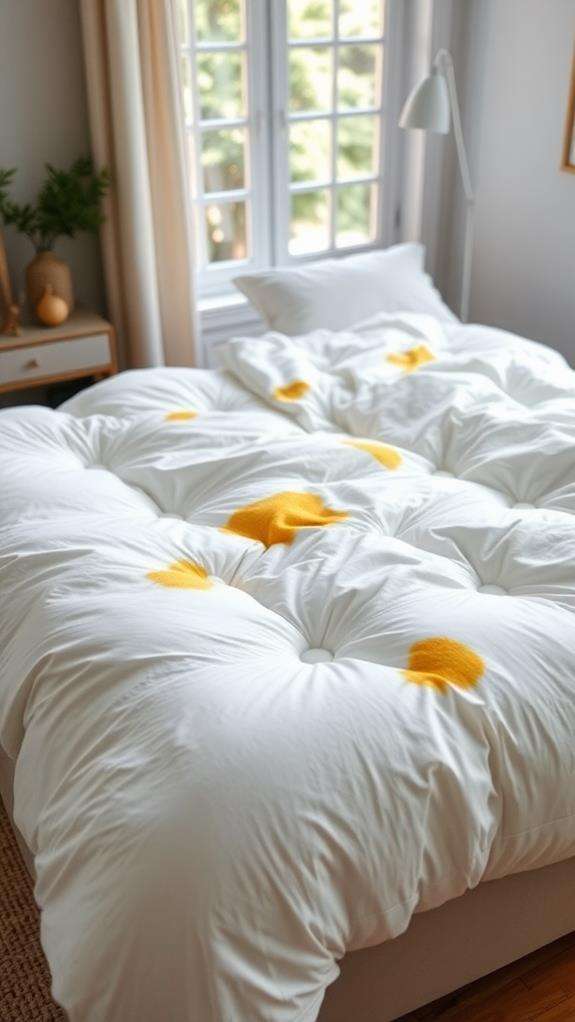
Five main culprits contribute to those unsightly yellow stains on your comforter. The most common cause is the gradual buildup of body oils and sweat that occurs naturally during sleep. As you rest, your body releases these substances, which slowly seep into the fabric fibers and create those frustrating discolored patches you're seeing.
Your body's natural shedding process plays a significant role too. Every night, you shed thousands of dead skin cells that can become trapped in your comforter's fabric. When these cells mix with moisture and heat, they create an environment perfect for yellowing. If you're using harsh cleaning products, you might actually be making the problem worse, as certain detergents can react with your comforter's material and cause unexpected discoloration. Sunlight exposure is another factor you'll need to take into account, as prolonged exposure can fade white fabric and give it a yellowish tint. Finally, if you're not thoroughly rinsing your comforter during washing, leftover soap residue can combine with your body's natural oils and sweat, leading to those stubborn yellow stains you're trying to eliminate.
Required Cleaning Supplies
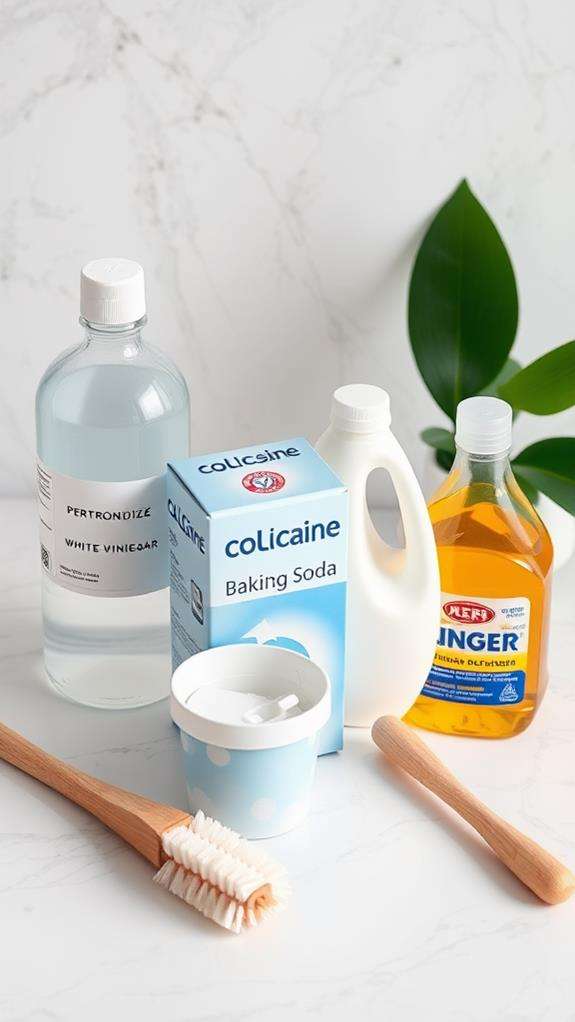
A successful comforter whitening project starts with gathering the right cleaning supplies. You'll need several key ingredients to effectively tackle those stubborn yellow stains and restore your comforter's bright appearance.
Start by gathering baking soda, which you'll need about half a cup of to boost cleaning power and eliminate unwanted odors. You'll also want to have a cup of gentle dish soap on hand, as it's essential for lifting stains without causing damage to your comforter's delicate fabric. Add half a cup of Borax to your cleaning arsenal, as it works synergistically with other ingredients to fight tough stains. For natural bleaching power, you'll need either white vinegar or lemon juice, which can help brighten the fabric without using harsh chemicals that might damage the material. Don't forget to include a gentle laundry detergent that's specifically formulated for down or feather comforters – this is vital for maintaining your comforter's quality during the cleaning process. Keep these supplies organized and easily accessible before you begin the whitening process, as having everything ready will make the task more efficient.
Natural Whitening Methods

You'll find amazing results by combining distilled white vinegar and baking soda in water for a powerful natural whitening solution that can revive your yellowed comforter within hours. For stubborn stains, make a baking soda paste to pre-treat specific spots before washing, letting the mixture sit for maximum effectiveness. To enhance your comforter's brightness naturally, try a lemon juice treatment followed by sun-drying, which works together to create a chemical-free brightening process that leaves your bedding fresh and naturally white.
Vinegar Soaking Solution Steps
Looking to restore your yellowed comforter's brightness naturally? A vinegar soaking solution provides an effective, chemical-free method to tackle those stubborn yellow stains and restore your bedding's original color.
Start by filling a large tub or bucket with warm water, then add one cup of distilled white vinegar to create your whitening solution. You'll want to fully submerge your comforter in this mixture, ensuring every part of the fabric is covered. Let it soak for 3-5 hours, allowing the vinegar's natural acidity to break down discoloration and eliminate any lingering odors.
Once the soaking period is complete, transfer your comforter to your washing machine. Add your regular gentle detergent and another cup of vinegar to enhance the cleaning process. Run the machine on a gentle cycle with warm water to protect both the fabric and filling. After washing, dry your comforter on low heat, and if you'd like to maintain its fluffiness, add a few dryer balls or clean tennis balls in socks during the drying cycle. This simple process won't just whiten your comforter—it'll also leave it fresh and thoroughly cleaned.
Baking Soda Deep Clean
While vinegar offers one natural solution, baking soda provides an equally powerful yet gentle method for whitening your yellowed comforter. Start by mixing 1/2 cup of baking soda with warm water in a bucket, creating a solution that'll effectively tackle those stubborn yellow stains.
You'll want to fully submerge your comforter in this mixture and let it soak for 3-5 hours, allowing the baking soda's natural abrasive properties to work their magic. During this time, the solution will gradually lift stains while neutralizing any unpleasant odors that have built up in your bedding. When you're ready to wash, transfer your comforter to a front-loading machine, and add 1 cup of dish soap along with your regular gentle detergent.
This baking soda treatment isn't just about immediate results – it's an investment in your comforter's longevity. The process helps prevent the accumulation of body oils and grime that can lead to future yellowing. Remember to use a large-capacity machine to facilitate thorough rinsing, as any leftover baking soda residue could affect the final results of your whitening efforts.
Lemon-Based Brightening Treatment
Lemon juice steps up as nature's powerhouse for restoring your comforter's bright white appearance. This natural citrus solution works effectively when combined with proper washing techniques to break down stubborn yellow stains and restore your bedding's original brightness.
| Step | Instructions |
|---|---|
| Preparation | Mix equal parts lemon juice and water in a spray bottle |
| Application | Spray mixture directly onto yellowed areas |
| Deep Soak | Add 1 cup lemon juice to warm water bath, soak 3-5 hours |
| Washing | Use gentle cycle with mild detergent, rinse thoroughly |
| Drying | Hang in direct sunlight for enhanced brightening effect |
You'll want to target the yellowed areas directly with your lemon juice solution before proceeding with a full wash. For particularly stubborn stains, you can create a more concentrated soaking solution. After applying your chosen lemon-based treatment, it's vital to wash your comforter thoroughly to remove any residual acidity. Don't skip the final step of sun-drying – it's not just for drying but actually enhances the brightening effect through natural UV exposure. This method works particularly well when you're dealing with older stains that haven't responded to conventional washing methods.
Pre-Treatment Steps
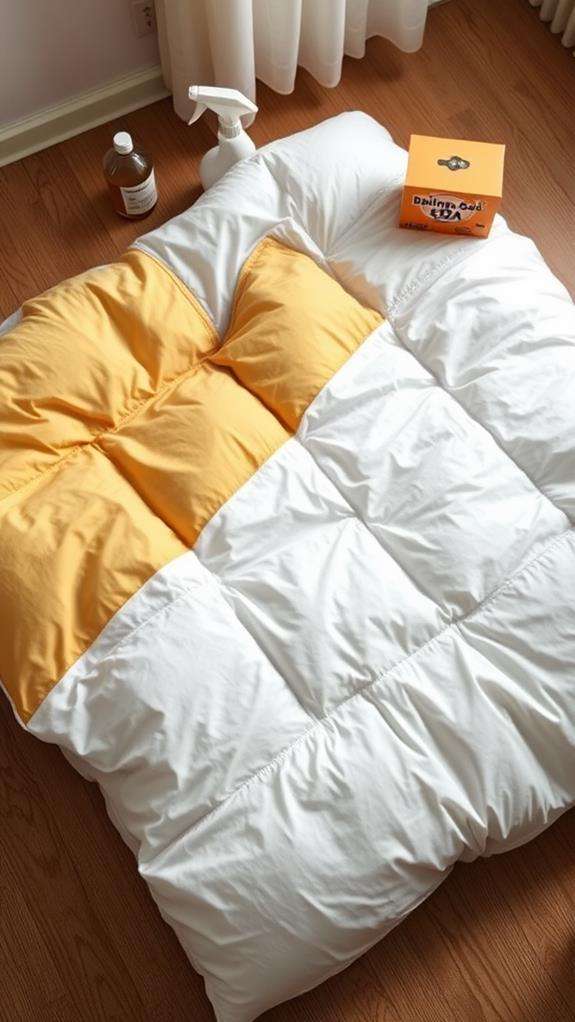
Before tackling the yellowing of your comforter, you'll need to carefully review the manufacturer's care label and follow any specific cleaning instructions to avoid damaging the fabric. Next, thoroughly shake out your comforter and use a soft brush to remove loose dirt, dust, and debris that could interfere with the whitening process. Once you've cleared away surface particles, examine the comforter closely and mentally categorize the different types of stains you find, as each type may require a specific pre-treatment method for the best results.
Check for Cleaning Instructions
Taking proper preparatory steps is essential to successfully whitening your comforter. Before you begin any cleaning process, you'll need to carefully examine the care instructions label attached to your comforter, as this will provide vital information about suitable cleaning methods and temperature settings.
Once you've located the care label, check whether your comforter is machine-washable or requires professional cleaning. While most high-quality down comforters can handle machine washing, some delicate materials might need specialized care. You'll want to thoroughly inspect your comforter for any damage, such as tears, loose stitching, or escaping feathers. If you find any holes, repair them with matching thread before proceeding with the cleaning process.
Next, remove any additional bedding accessories like duvet covers or decorative throws, as these items often require different cleaning approaches. Before proceeding with a full wash, you'll need to address any visible stains. You can do this by spot-cleaning with either a gentle detergent solution, a baking soda paste, or a mixture of vinegar and water, depending on the type of stain you're treating.
Remove Surface Debris First
A thorough pre-treatment of your comforter is essential for achieving the best whitening results. Before you begin the cleaning process, you'll need to remove surface debris and inspect your comforter carefully for any issues that could affect the whitening outcome.
Start by spreading your comforter on a clean, flat surface and examine it thoroughly for stains, discoloration, or damage. Check for loose feathers and tears in the fabric, and if you find any holes, stitch them up with matching thread to prevent further damage during washing. Next, use a soft-bristled brush or your vacuum's fabric attachment to gently remove dust, dirt, and other debris from the comforter's surface. Pay special attention to seams and corners where debris often accumulates.
Once you've addressed any visible dirt, spot-treat stubborn stains using a mild detergent or a solution of water and white vinegar. Apply the cleaning solution directly to the stained areas with a clean, soft cloth, being careful not to oversaturate the fabric. Finally, verify your comforter is properly fluffed and evenly distributed before proceeding with the main cleaning process.
Sort by Stain Type
Now that you've removed surface debris, identifying specific stain types will determine your pre-treatment approach. Examine your yellowed comforter carefully to determine whether the discoloration stems from sweat and body oils or detergent buildup, as each requires different treatment methods.
For sweat and body oil stains, you'll want to create a baking soda paste with water. Apply this mixture directly to the yellowed areas and let it sit for at least 30 minutes before proceeding with your wash cycle. If you suspect detergent residue is the culprit, prepare a solution of one cup of white vinegar in warm water, then soak your comforter for 3-5 hours to break down the buildup.
For particularly stubborn yellowing, combine lemon juice with baking soda to create a natural brightening paste. Before applying any treatment, don't forget to conduct a spot test in an inconspicuous area of your comforter. This essential step guarantees the solution won't damage or further discolor your fabric. Wait 15-30 minutes after applying the test mixture to check for any adverse reactions.
Washing Machine Settings
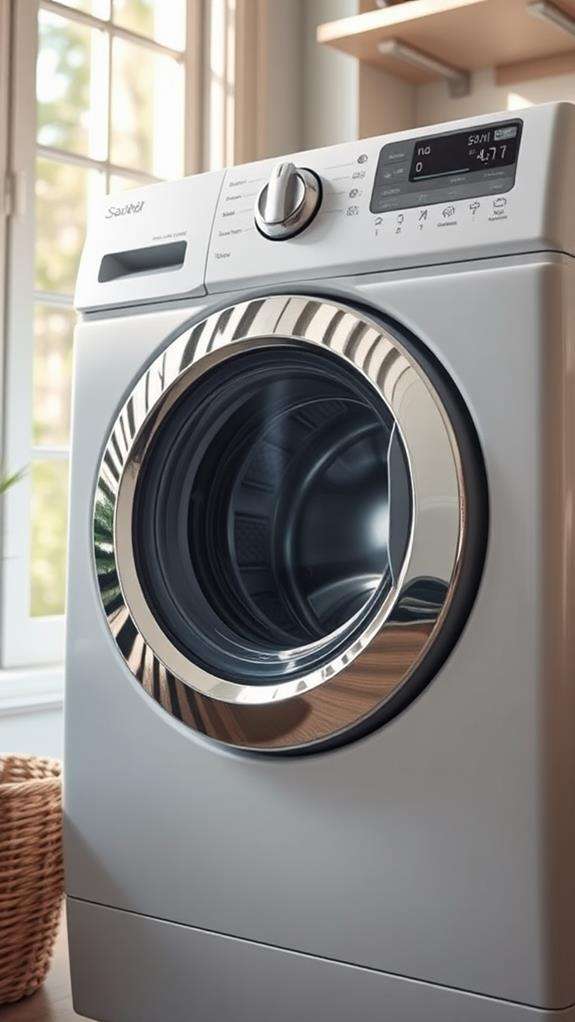
When it comes to machine washing your comforter, selecting the right settings makes all the difference in achieving a whiter, brighter result. To protect your white comforter while guaranteeing thorough cleaning, you'll want to choose a front-loading washing machine, which provides gentler agitation compared to top-loading models with aggressive agitators.
Start by setting your machine to a gentle cycle, which will effectively clean your comforter without putting excessive stress on the fabric. Select warm water temperature, as it's ideal for activating cleaning agents while protecting the material's integrity. You'll also want to add an extra rinse cycle to your settings, which helps eliminate all traces of detergent that could lead to yellowing over time. Throughout the washing process, keep an eye on your comforter to verify it's moving freely in the drum. If you notice it's too cramped, you might need to take it to a laundromat with larger capacity washing machines. Remember, proper movement during washing is essential for achieving even cleaning results and maintaining your comforter's pristine white appearance.
Drying Best Practices
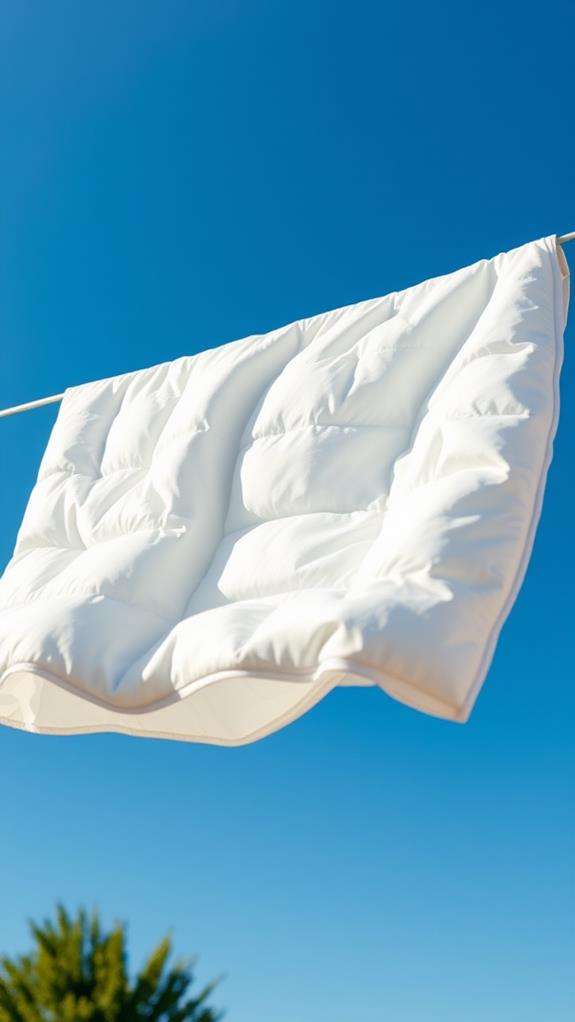
When it comes to drying your freshly washed comforter, you've got two effective options: sun drying outdoors or using your dryer machine. While sun drying naturally whitens and deodorizes your comforter through UV exposure, machine drying with dryer balls offers more control over the process, especially during unfavorable weather conditions. For the most effective results in either method, you'll want to periodically redistribute the filling by giving your comforter a good shake or fluff, ensuring the inner material doesn't clump and maintains its even distribution throughout the drying process.
Sun Drying Vs Machine
The choice between sun drying and machine drying your comforter comes down to both convenience and desired results. When you opt for sun drying, you'll benefit from natural bleaching properties that can effectively reduce yellowing without harsh chemicals. However, if you're choosing machine drying, you'll need to dedicate 4-10 hours on a low heat setting while using dryer balls to maintain the down's integrity.
| Feature | Sun Drying | Machine Drying |
|---|---|---|
| Time Required | 4-8 hours | 4-10 hours |
| Whitening Effect | Natural bleaching | No whitening effect |
| Equipment Needed | Clothesline/rack | Dryer & balls |
| Weather Dependent | Yes | No |
| Maintenance | Periodic rotation | Regular fluffing |
To enhance your results with machine drying, you'll need to pause periodically to redistribute the filling and prevent clumping. Don't overload your dryer, as a cramped comforter won't dry evenly. If you're using sun drying, you'll achieve superior whitening results, but you're at the mercy of weather conditions. Consider combining both methods by starting with sun exposure for whitening, then finishing in the dryer to guarantee thorough drying and peak fluffiness.
Maintaining Even Heat Distribution
Maintaining even heat distribution during the drying process stands as a critical factor in successfully whitening your comforter. To achieve ideal results, you'll need to focus on creating consistent airflow and preventing clumping throughout the drying cycle.
Start by placing dryer balls or clean tennis balls in your dryer alongside your comforter. These balls help break up any clumps that form while maintaining steady heat distribution throughout the material. You'll want to set your dryer to a low heat setting, which prevents damage to the filling while guaranteeing consistent temperature throughout the fabric. Don't overfill the dryer; your comforter needs room to move freely for proper air circulation.
Throughout the drying process, which can take anywhere from 4 to 10 hours, you'll need to pause periodically to manually fluff and redistribute your comforter. This extra step might seem tedious, but it's essential for maintaining even drying and preventing moisture pockets that could lead to mildew. Each time you pause the cycle, take a moment to reshape the comforter and confirm it isn't bunched up in one area of the dryer.
Professional Cleaning Options
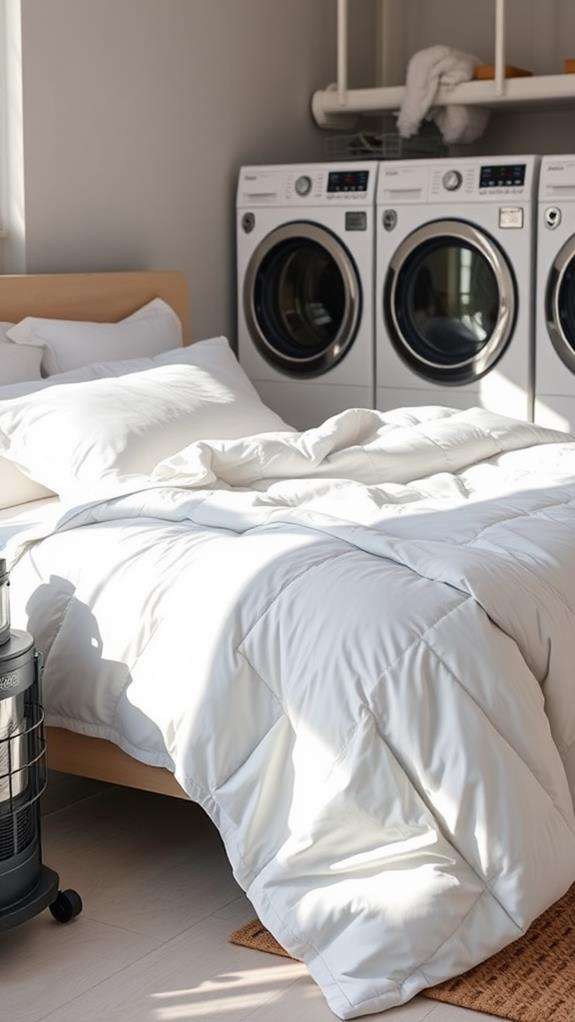
Professional cleaning services offer a powerful solution for restoring yellowed comforters to their original brightness. Unlike home treatments that might involve harsh chemicals, professional dry cleaning specialists use commercial-grade equipment and specialized cleaning agents designed specifically for delicate materials.
| Service Feature | Benefits | Average Cost |
|---|---|---|
| Commercial Equipment | Superior cleaning power | $30-45 |
| Specialized Solutions | Safe for delicate fabrics | $15-25 |
| Sanitizing Treatment | Eliminates bacteria | $20-30 |
| Deodorizing Service | Removes stubborn odors | $10-20 |
| Delivery Options | Door-to-door convenience | $15-25 |
You'll find that professional cleaners can address yellowing issues while maintaining your comforter's structural integrity. Their industrial-sized machines provide thorough cleaning that's difficult to achieve at home, and they're equipped with temperature-controlled systems that protect the down filling. Most services also include convenient pickup and delivery options, saving you the hassle of transporting bulky bedding. While professional cleaning may cost more than DIY methods, it's recommended every few years to maintain your comforter's appearance and extend its lifespan. The combination of expert handling and specialized equipment guarantees your bedding receives the most effective treatment possible.
Preventing Future Yellowing
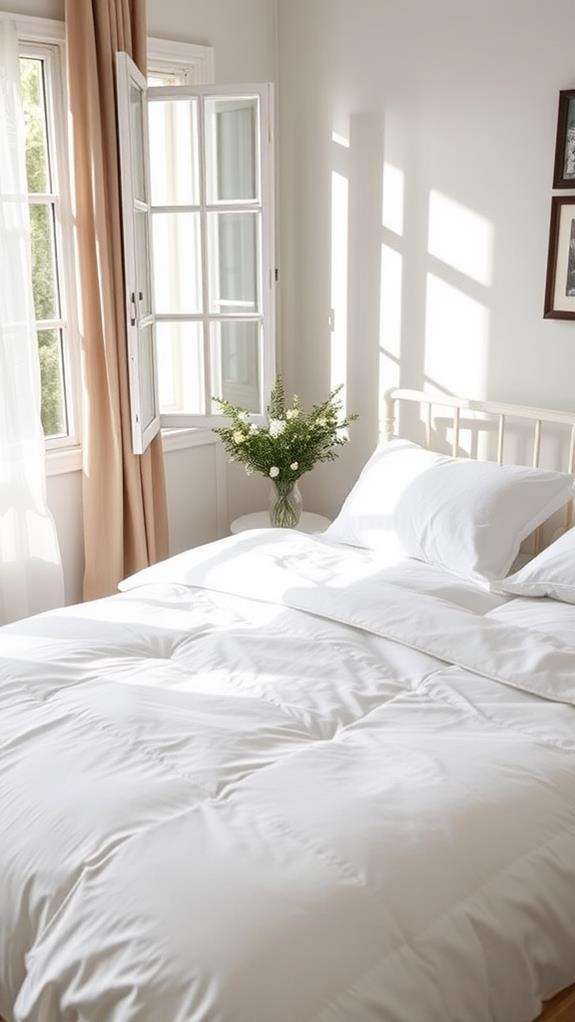
While professional cleaning can restore your comforter's whiteness, taking preventive steps will help you avoid frequent trips to the cleaners. The best option for preventing future yellowing starts with establishing a regular maintenance routine that includes annual washing using mild, non-chlorine detergents specifically formulated for white fabrics, which will protect your comforter's fibers while maintaining brightness.
You'll want to invest in high-quality, washable protectors that create a barrier between your comforter and body oils, sweat, and other substances that contribute to yellowing. When you're not using your comforter, store it properly in a breathable fabric bag, avoiding plastic containers that can trap moisture and lead to mildew. If you're looking for a natural brightening solution, try hanging your comforter outside occasionally, as sunlight's UV rays can help maintain whiteness while naturally disinfecting the fabric. Remember to choose a cool, dry storage location to prevent moisture accumulation, and always verify your comforter is completely dry before storing it away. By implementing these preventive measures consistently, you'll greatly extend the time between professional cleanings and maintain your comforter's pristine appearance.
Storage and Maintenance Tips
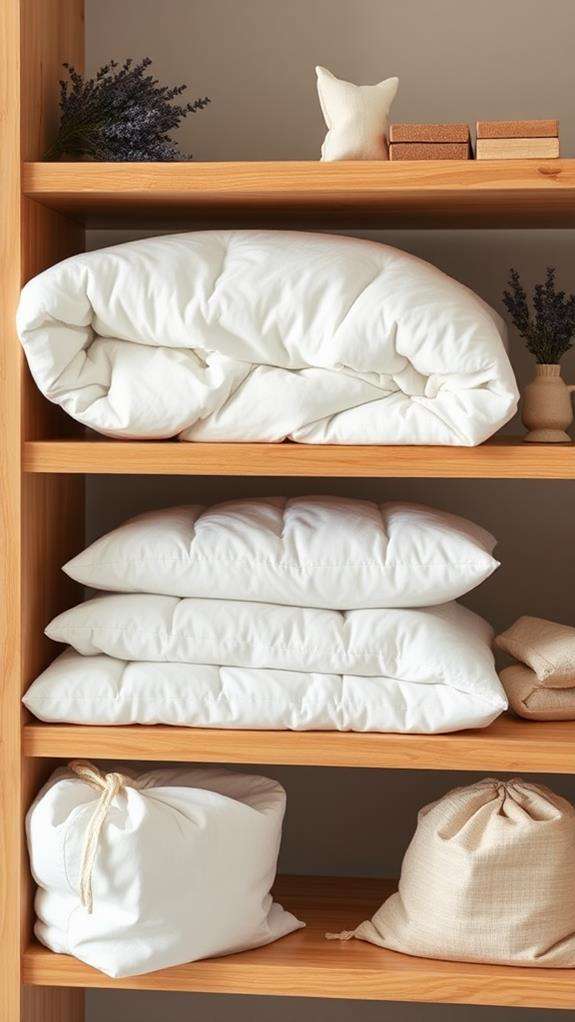
Proper storage and regular maintenance form the foundation of keeping your white comforter in pristine condition. When you're not using your comforter, store it in a breathable cotton or linen bag that allows air circulation while protecting it from dust and debris. You'll want to avoid plastic containers or vacuum-sealed bags, as these can trap moisture and lead to unwanted yellowing or mildew growth.
Choose a cool, dry storage location away from direct sunlight, as UV rays can cause gradual fading and discoloration of your comforter's fabric. During storage periods, make sure you're not compressing the comforter too tightly, as this can damage its filling and prevent proper air circulation. To maintain your comforter's quality while it's in use, establish a regular maintenance routine that includes frequent fluffing and rotation. This helps distribute the filling evenly and prevents particular sections from wearing out faster than others. Don't forget to use washable protectors on your comforter, as they'll create a barrier against body oils and sweat that typically cause yellowing. These protective covers are easy to remove and clean, making your maintenance routine much more manageable.
Alternative Bleaching Solutions
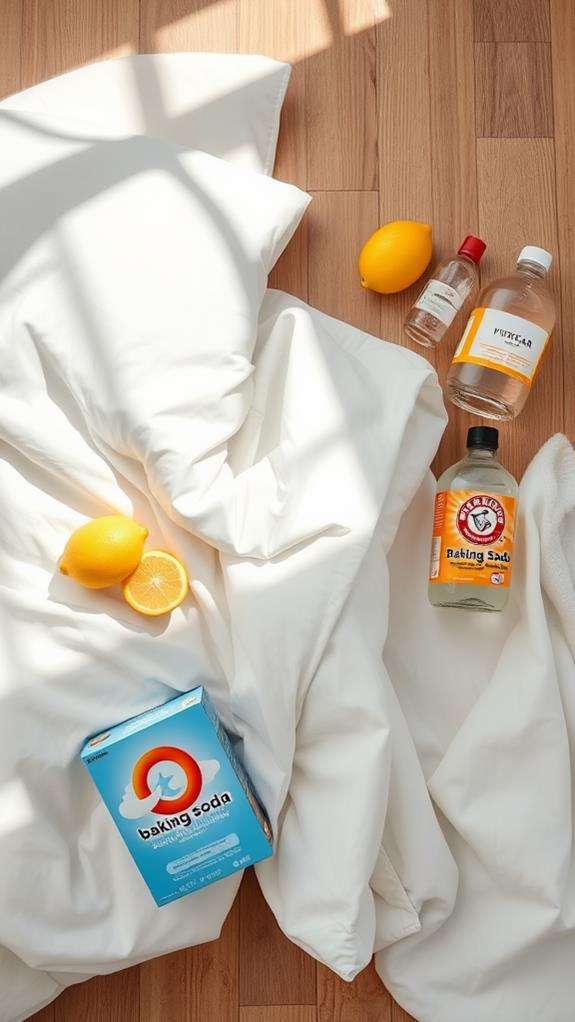
Natural alternatives to chemical bleach can effectively restore your comforter's brightness without harsh effects on fabric or the environment. Additionally, using safe, high-quality materials like those found in kitchen storage solutions, such as FastRack glass jars, allows for effective preservation of ingredients that can enhance your cleaning methods. When your comforter starts showing signs of yellowing, you'll find several household items can serve as gentle yet effective whitening agents. White vinegar and baking soda, two common kitchen staples, work together to break down stubborn stains and restore your comforter's original brilliance.
Here are three powerful natural whitening methods you can try:
- Mix one cup of baking soda with your regular detergent during the wash cycle, then add 1/2 cup of white vinegar during the rinse cycle to neutralize odors and boost brightness.
- Create a paste using lemon juice and baking soda, applying it directly to yellowed areas before washing your comforter in warm water.
- Combine equal parts hydrogen peroxide and water in a spray bottle, lightly mist the yellowed areas, then wash as usual.
For particularly stubborn yellowing, you can enhance these methods by adding 1/2 cup of Borax to your wash cycle. This natural mineral will work alongside your chosen solution to soften water and improve overall cleaning effectiveness.
Frequently Asked Questions
How Do You Whiten Yellowed Bedding?
Like breathing new life into tired linens, you can restore yellowed bedding with a simple solution. Mix 1/2 cup baking soda and 1 cup dish soap in water, then soak your bedding for 3-5 hours. Follow up by washing with gentle detergent and a cup of vinegar or lemon juice. For extra whitening power, you'll want to add non-chlorine bleach, or stick to natural alternatives. Don't forget to air dry in sunlight for best results.
Why Do Comforters Turn Yellow?
Your comforter's yellowing is primarily caused by natural body processes and environmental factors. When you sleep, you're releasing sweat, body oils, and dead skin cells that gradually accumulate in the fabric. Exposure to sunlight can also break down the fibers and cause discoloration. If you're using harsh detergents, they'll leave residues that mix with these bodily substances, making the yellowing worse. Improper washing and storage can also speed up this process.
How Do You Fix a Discolored Comforter?
While you might think a discolored comforter is ruined forever, it's actually quite fixable. You'll want to soak it in a mixture of warm water with 1/2 cup each of baking soda and Borax for 3-5 hours. Then, wash it using gentle detergent and 1 cup of dish soap on a delicate cycle. Don't forget to rinse twice, and dry on low heat with dryer balls. For extra whitening power, you can add lemon juice or white vinegar to the wash.
How Can I Whiten My Comforter Without Bleach?
You can whiten your comforter naturally by soaking it in a mixture of 1/2 cup baking soda and warm water for 3-5 hours. When washing, add 1 cup of dish soap and gentle detergent to your machine. Pour 1 cup of white vinegar in the fabric softener compartment during the rinse cycle. For best results, air dry your comforter in direct sunlight, or if using a dryer, add dryer balls on low heat to maintain fluffiness.





